How to Create a Custom WooCommerce Profile Page
Have you ever wanted a more advanced WooCommerce customer profile page? Somewhere where you would have all the important information about a customer in a single well-organized place. In the following tutorial, I will show you how to create advanced customer profiles for your WooCommerce shop that you can use to store custom customer information that can always be available for you and your team.
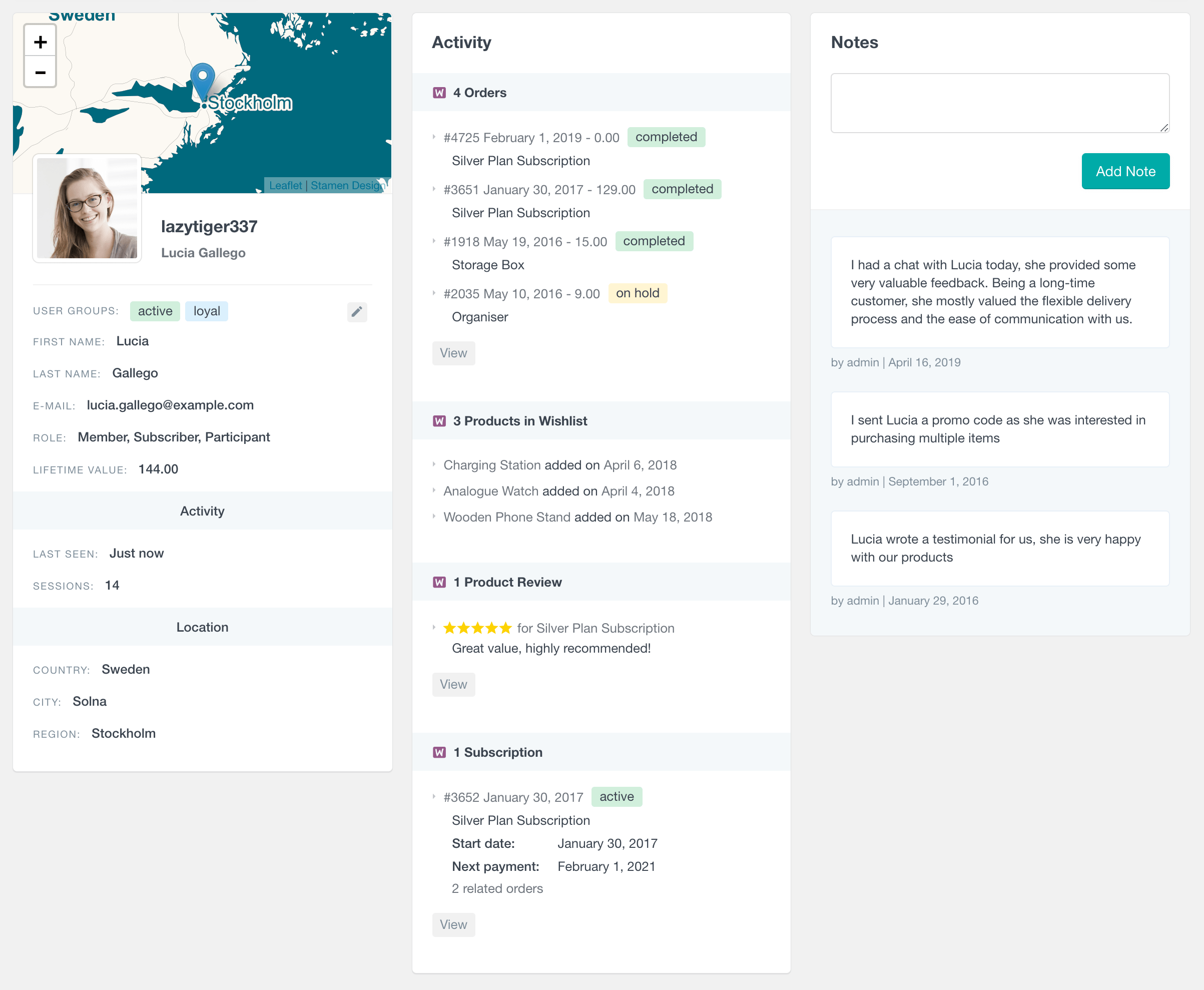
Why create a WooCommerce customer profile
Your WooCommerce store has a lot of (useful) information about your customer. Unfortunately, this information is fragmented through your WordPress setup in the form of purchasing info, personal information, customer activity, etc. In addition to this, there are also a lot of customer details that you and your staff know about some customers.
Having one place where all this comprehensive and neatly organized customer information is available can help run your business more smoothly. Here are some of the benefits of using custom customer profiles for your online store:
- All the information is available on a single page.
- It improved WooCommerce customer management.
- Create and share (internal) customer notes.
- Add customer information that is relevant to your store.
- Reduce confusion and errors.
- Better understand your customers.

How to create a custom user profile
A custom WooCommerce customer profile is an advanced customer profile page that can be created using the Users Insights plugin. This page allows you to store custom customer information that can be always available for you and your team. You can use this feature to understand your customers better, improve customer management, reduce confusion and errors, and create and share internal customer notes.
First, before creating our custom WooCommerce customer pages, we must have the Users Insights plugin installed and the WooCommerce module for User Insights activated. You can activate the module from the modules section of the plugin.
We will also use the Custom User Fields and the Customer and User Notes features for this tutorial. Both of these features come with the Users Insights plugin by default.
Since Users Insights is a WordPress user management plugin, this feature would work only with WooCommerce customers who are registered users on your installation.

The default WooCommerce customer profile page
To access the default user profile page of Users Insights, you only need to click on a particular user’s username from the user list in your WooCommerce customer dashboard. This will open a page that can look like this:
As you can see from the start, you get a pretty nice customer profile page with much additional customer information compared with the default WooCommerce My Account page. Here are some of the most important parts of the customer profile information that are available by default:
- Personal details like username, name, person avatar, email address, and user role
- Customer groups
- Customer location: city, region, and country
- Location is shown on an interactive map
- WooCommerce customer history and actions like WooCommerce orders made, as well as Posts, Pages, Comments, and Custom Post Types Created
- WooCommerce customer activity tracking includes last seen, number of sessions, page visited, etc.
- WooCommerce customer notes section.
Depending on the Users Insights modules that you have active on your website, you might see another type of customer information like Customer Device info or user membership information. as well as data from WooCommerce extensions like WooCommerce Subscription and WooCommerce membership.
There is also the user activity tracking list section. This is where you can see a group of content creation activities the customer has made, like posts, pages, comments, and custom post types. But more importantly, with the WooCommerce module activated, an “Orders” section will be added to the user activity, where you can see a list of each user’s recent WooCommerce customer order history. Each order has a link to its corresponding WooCommerce order page, where you can view and edit the order details. The list also includes a link to the WooCommerce order list page, showing the complete list of orders for the selected user only.
Custom fields can be used to collect additional customer information, such as website address or social media information, or to add custom fields relevant only to your specific WooCommerce store.
Another section that you might notice is the user/customer notes section. This can be a convenient feature as it allows you to add short text notes about the customer. Please check the article ” How to create WooCommerce customer notes article to learn more about the customer note feature.
Adding custom fields to your WooCommerce user profile
But what if you have some custom customer information that you want to add to your WooCommerce user profile? This is when we can use custom fields.
What are WooCommerce profile custom fields?
WooCommerce profile custom fields are additional fields that can be added to the default WooCommerce registration fields. These fields can be used to collect more custom user information, such as website address or social media information, or to add custom fields relevant only to your specific WooCommerce store to make it easier to purchase WooCommerce products. You can use the Users Insights plugin to add custom fields to your WooCommerce customer profile or customize my account page and edit profile data of existing custom fields.
How to add custom fields to the WooCommerce profile
This can be custom field data added by different WordPress plugins, WooCommerce plugins, or the WordPress theme. For example:
- Profile field data added by the user registration form on your user registration page. Many WordPress user profile builders and membership plugins add custom user profile fields to store additional user data. Note: The plugin will load the field data automatically out of the box for plugins like Profile Builder Pro, Ultimate Member, and Memberpress. You can use the method described below to add others to the WooCommerce user accounts.
- WooCommerce user profile field data is stored during the checkout or WooCommerce account registration process. This data can be added by a specific WooCommerce login and registration plugin or with a custom code via a custom WooCommerce registration form by the WordPress theme.
This is where the custom user fields functionality of Users Insights comes in handy. The custom user fields section of the User Insights plugin allows you to add custom information to your customer profile. This can be a phone number, some status, some important date, organization, nickname, gender, etc.
You can add a new WooCommerce customer custom field from the Custom User Fields section of the Users Insights plugin.
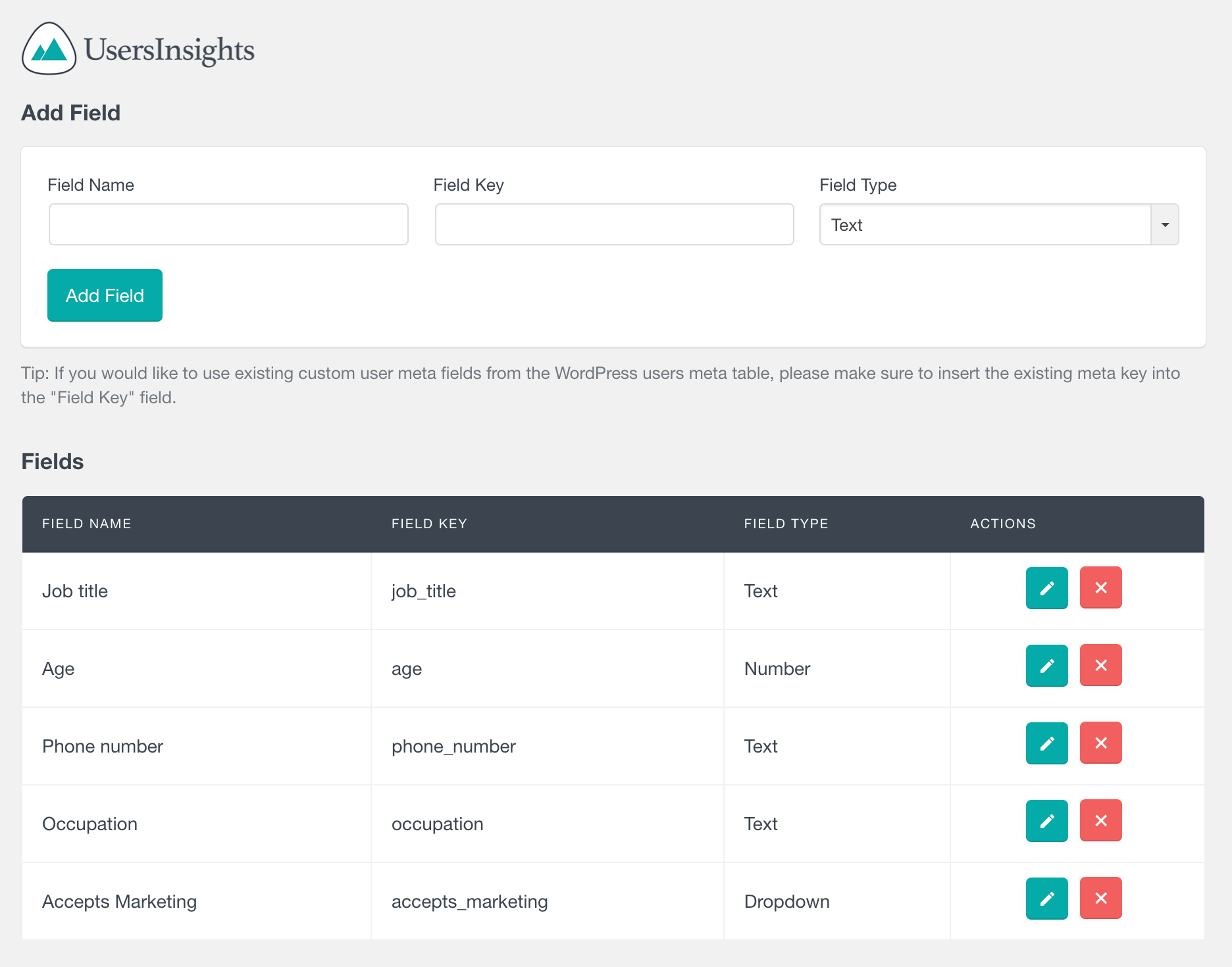
Here, you will see a list of all custom WooCommerce user profile fields you have created (if any) and the form to add a new WooCommerce customer custom field. For our example, let’s say I want to add a phone number field for my customer. All I need to do is set the Field Name option to “Phone number,” choose a meta key name (in our case, this will be user-meta-phone), and select the type we want the field to be. Currently, the following field types are supported: text, number, dropdown, and date(read-only). We will select the text type and click add. And that’s it; now we have a new customer custom field available for us in the WooCommerce account page of Users Insights of every customer.
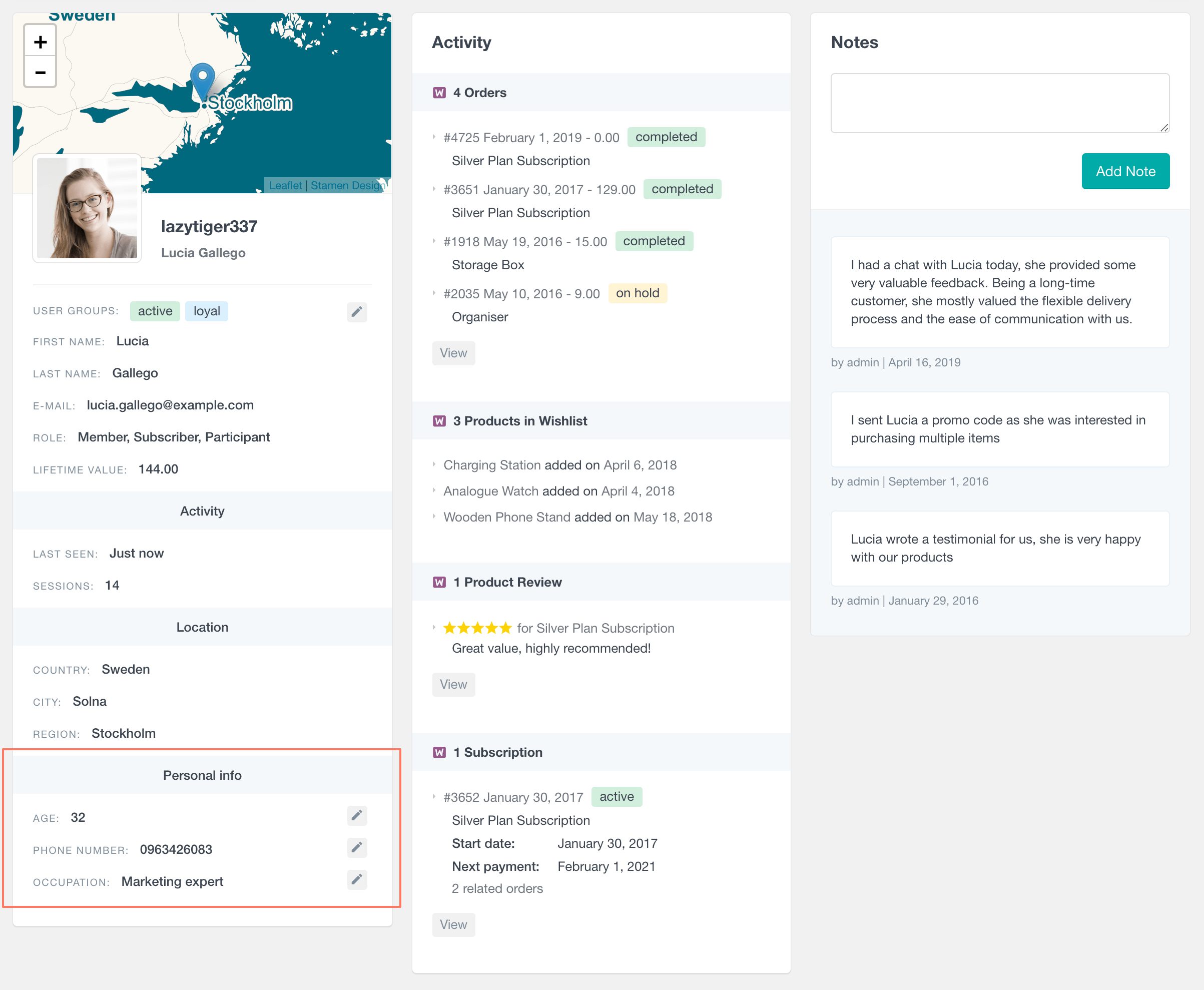
Adding and editing customer information via the custom user profile fields
Now that we have created the new WooCommerce customer custom field, we can easily customize and manage field data and add new information that we want to be available in our customer profile sections. Not only that, but we can also edit user profile data right from the account page. To do this, we only need to click on the edit icon on the right side of the newly created field. This will turn the text into a placeholder where we can add or edit the existing information.

Depending on the field type, there will be a different field input. For example, for numeric fields, there will be a number input, and for dropdown fields, you will see a select dropdown with all of the predefined options:
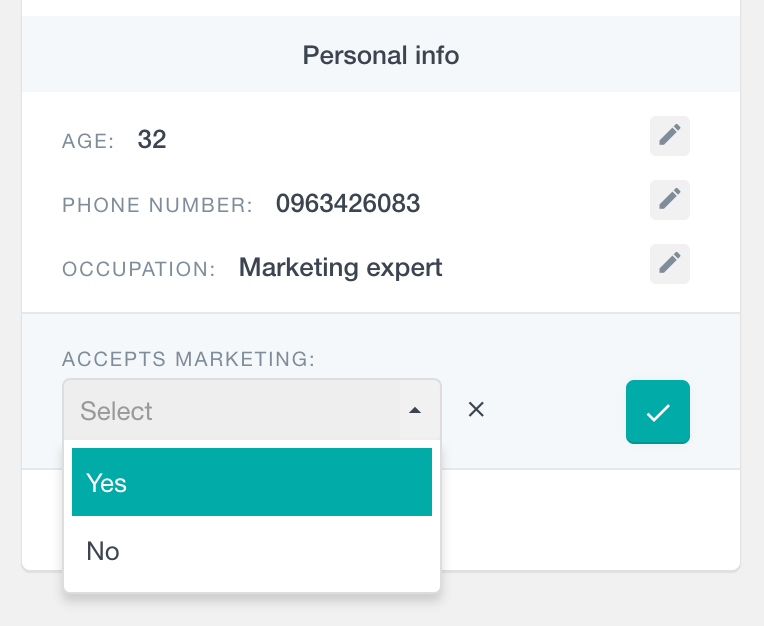
Loading existing WooCommerce checkout field data
Some of your WooCommerce checkout fields are stored as custom user meta fields. This is useful because it means we can quickly load this data into Users Insights. The process is the same as we’d do with other custom fields, but this time, we’ll need to use the WooCommerce keys. Here is an example of loading the billing and shipping address data as required:
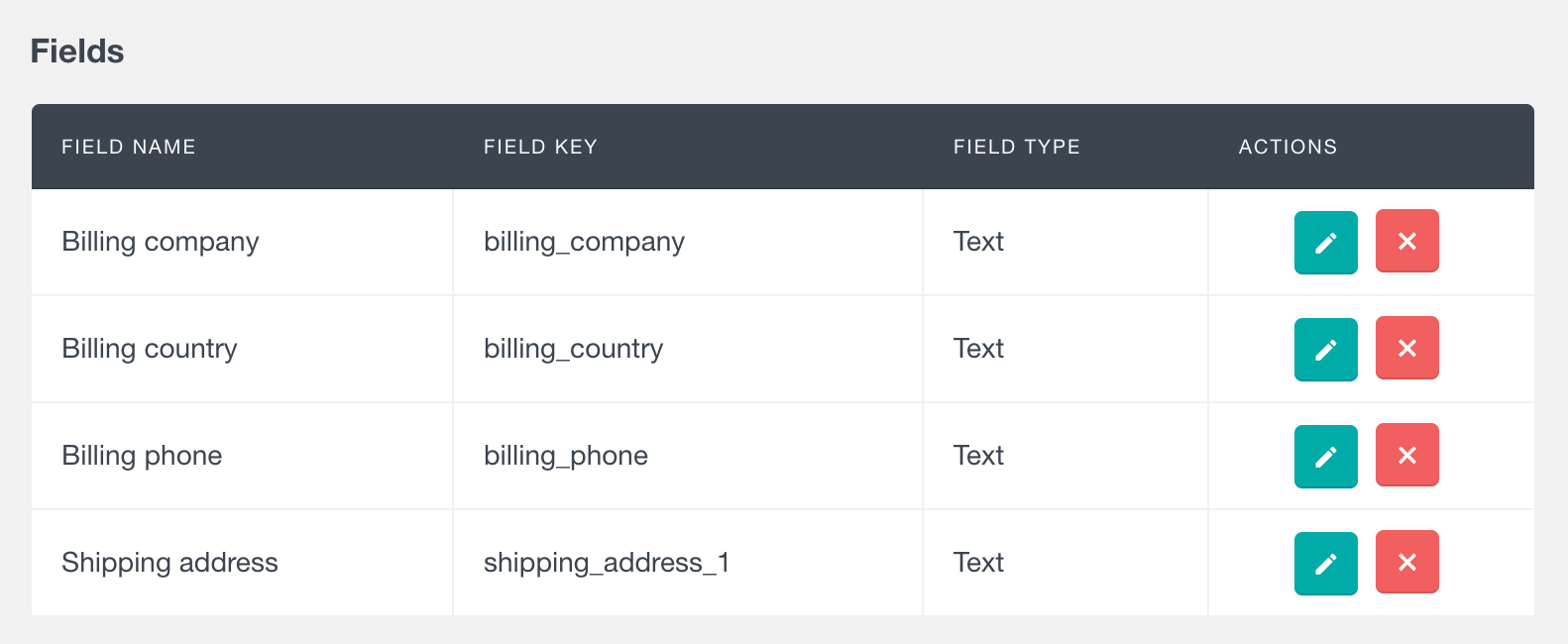
Once these user profile fields are mapped, you can see them on the customer profile page and use them in your filters, columns, and export files.
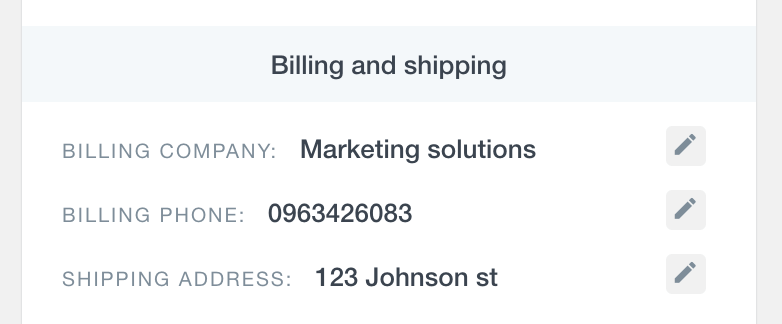
Search and filter WooCommerce customers by using custom field data
It is important to note that all this custom information is also available on the Users Insights user table and in the Users Insights smart filters, which means that you can search and filter your WooCommerce customers using this information.
You can make the custom fields visible on the user table by clicking the eye icon and selecting the names of the areas you want to show. Once you make them visible, you can easily preview the custom field data of your WooCommerce customers on the user table. You can also sort the table by any of these fields.
Here is an example where we have made the custom fields “Age”, “Phone Number” and “Occupation” visible in the user table, and sorted the user list by the age field:
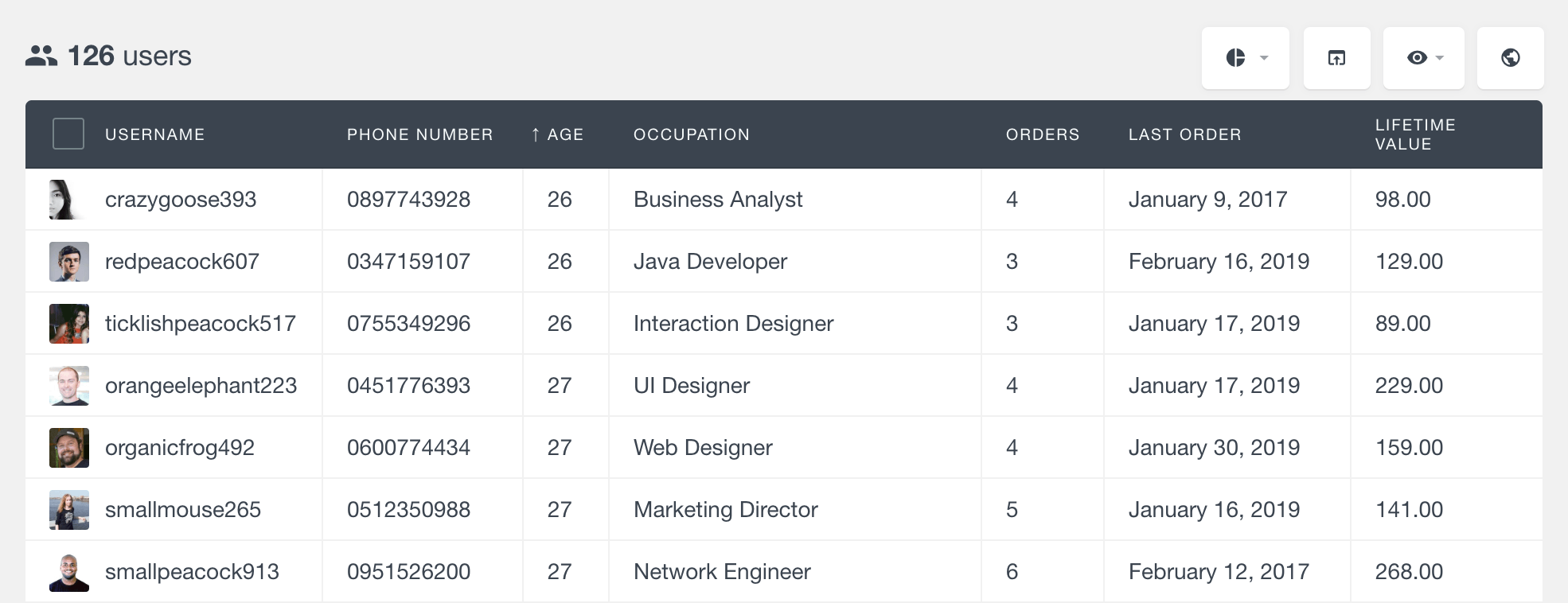
All the custom WooCommerce customer fields are also available in the Users Insights filters, meaning you can filter your customer list by any of those fields. For example, you might want to find the list of customers older than a specific age and/or those with management-related occupations. You can do all of this with the help of the Users Insights filters.
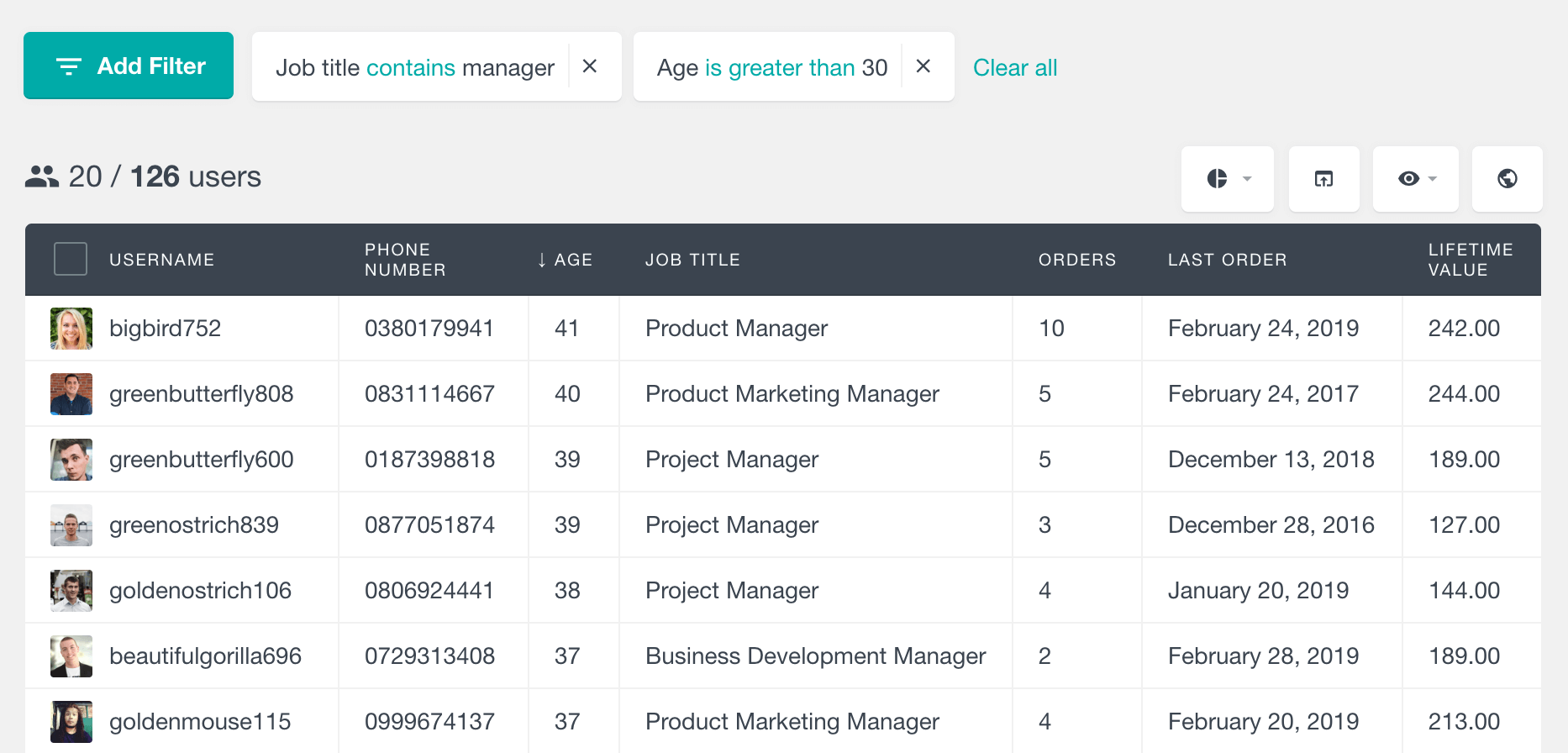
Now, we know how to filter users based on some of their custom fields. Let’s spice things up with a bit of WooCommerce data as well. There are a lot of WooCommerce-specific columns and filters that contain WooCommerce account data. For example:
- Customer lifetime value
- Number of orders
- First & Last order date
- Wishlist Products
- Reviews
- Purchased products
- Coupon usage
- Order Status
Let’s say you’ve run a campaign for developers and want to check out how many developers have used a specific coupon code. You can combine the “has used coupon” and the users’ occupation filters. You can even further segment the user list by the ordered products.
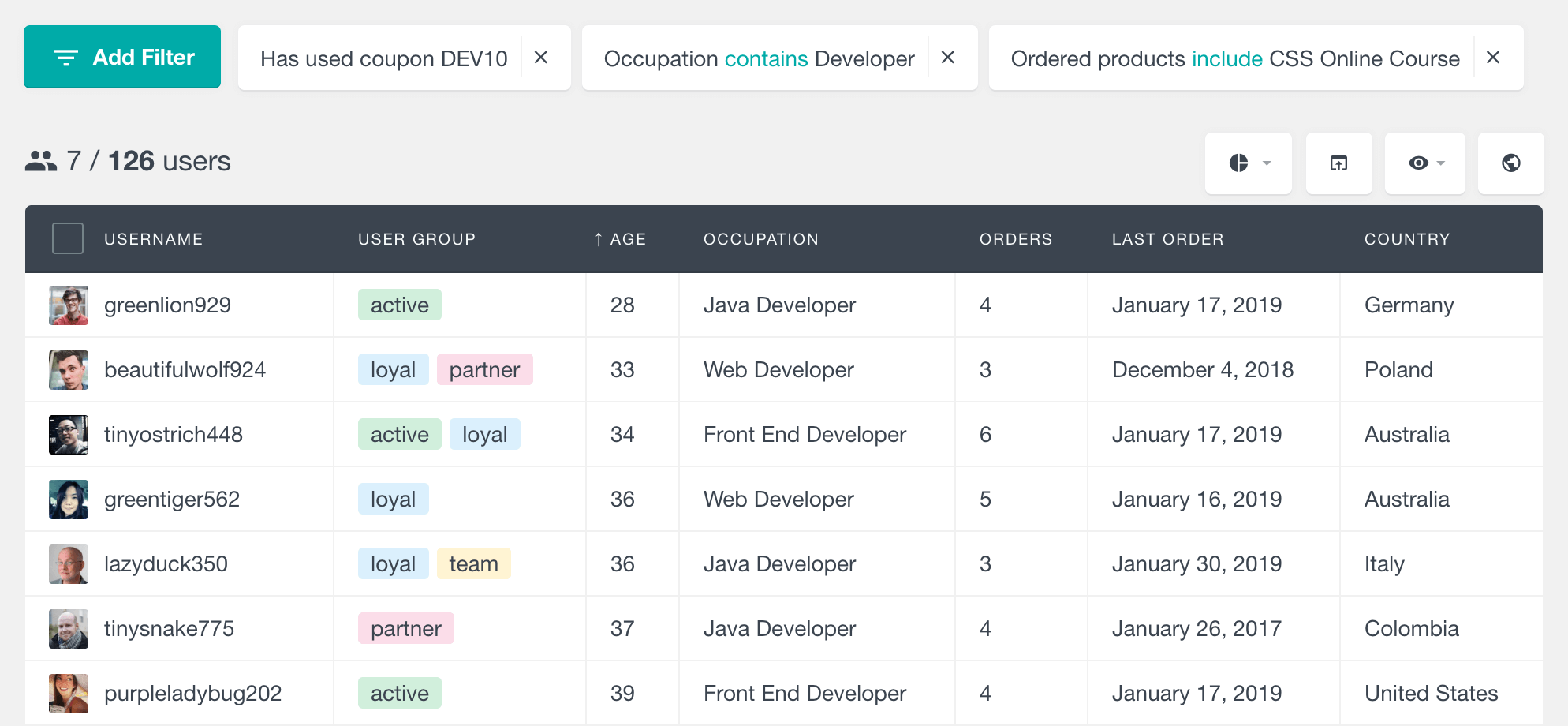
Likewise, you can check out how many customers used that coupon but aren’t developers.
Another idea is to use the customer lifetime value to find inactive but valuable customers. So if a high-ticket customer hasn’t visited your store for a long time, it’d be nice to reach out to them. There are a few things that a business owner can do to improve its customer lifetime value. Still, the basic principles are that customers must spend more (per item), purchase more often, and remain customers longer. So, if it has been a while since a high-ticket customer has ordered from you, it might be a good idea to consider some re-engagement strategy. The lifetime value date can be extracted from your WooCommerce user accounts in combination with the last seen filter.
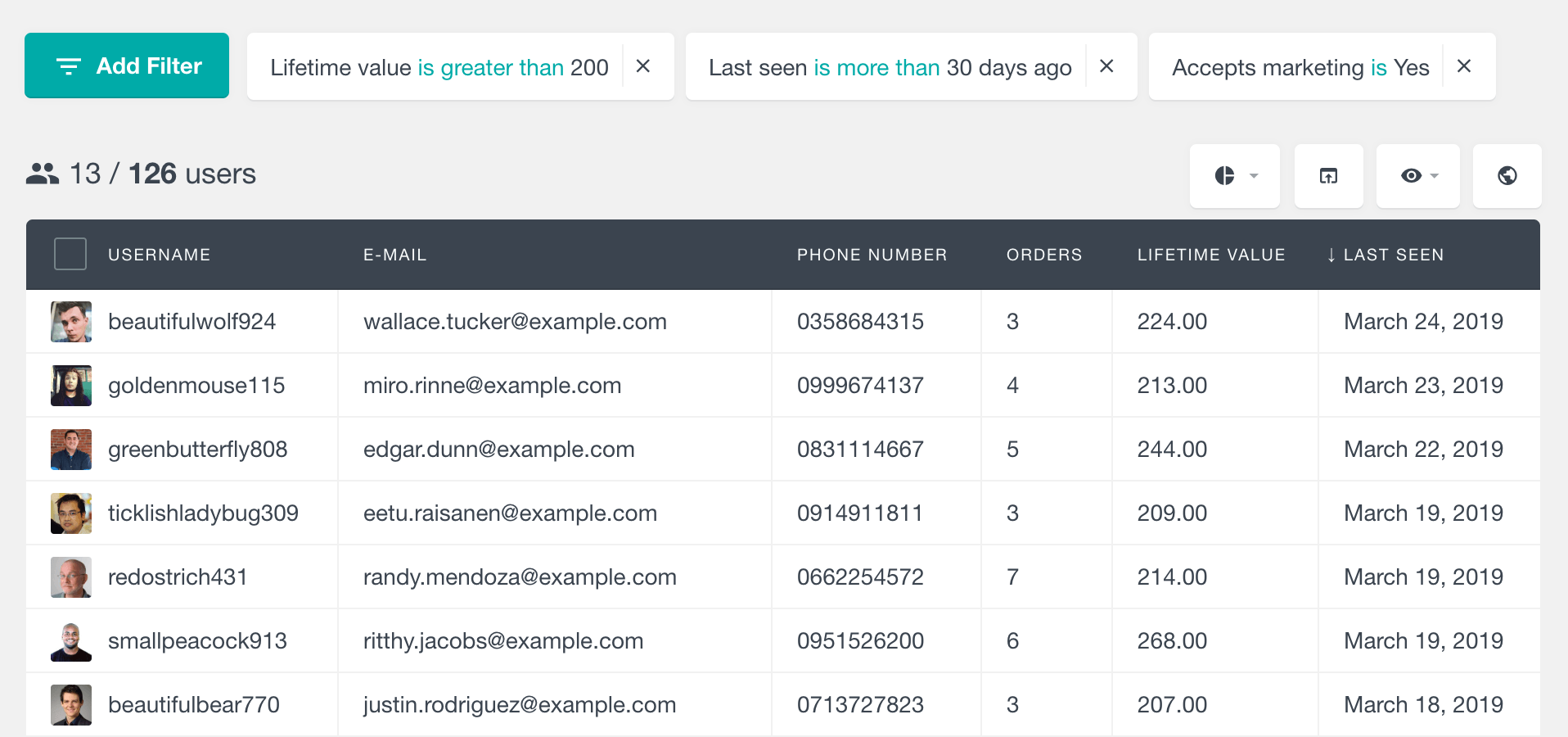
In addition to this, you can easily export your filtered customer list, including all the custom field data in a CSV format. In this way, you can use this data for your reports or perhaps create an email campaign to import a custom selection of customers along with the custom field data you need.
Organizing the WooCommerce customer profile fields
Suppose the number of custom fields you have for your customer profile gets larger. In that case, grouping them into different sections might be a good idea to improve readability and organization. This can be done from the Profile Settings option in the user profiles. To enable profile settings edit mode, click on the Profile Settings button in the top right corner:
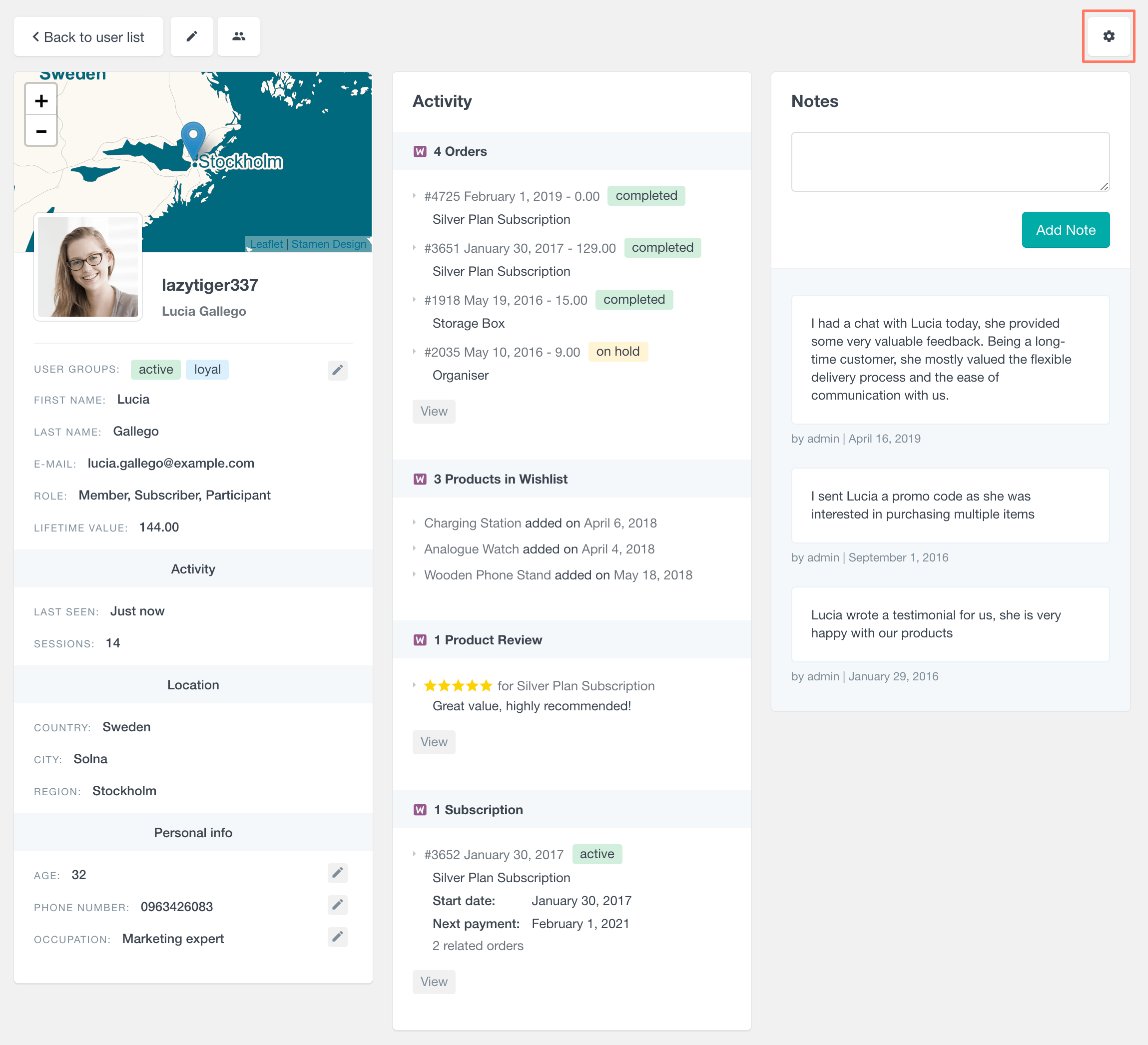
Profile field groups
Once the settings edit is activated, you get a new set of options. For instance, you can add groups for your custom fields. This helps you significantly when it comes to the custom field organization. In particular, if you have a lot of parcels coming from different plugins or belonging to different types.
You can add new sections using the “Add section title” option beneath your custom fields:
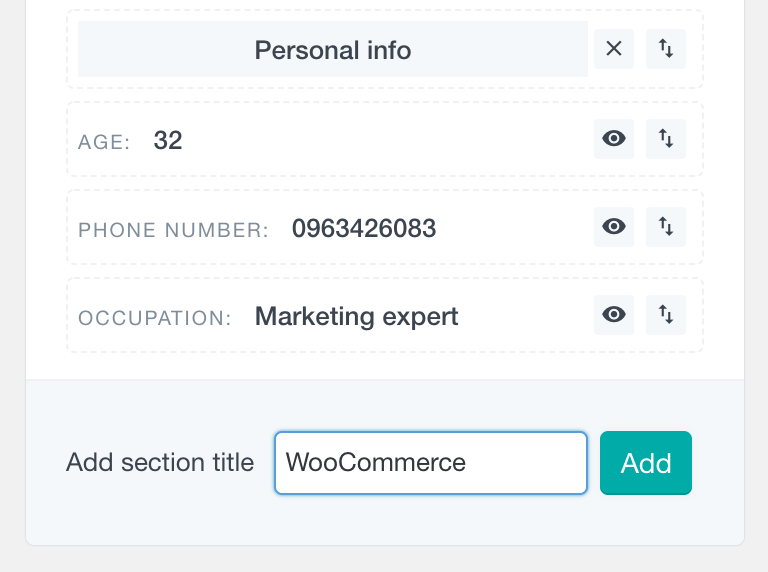
After adding the WooCommerce custom fields section, you can move it around using the arrows button, which acts as a drag-and-drop handle. This is a quick way to move it until it is where you want it to be.
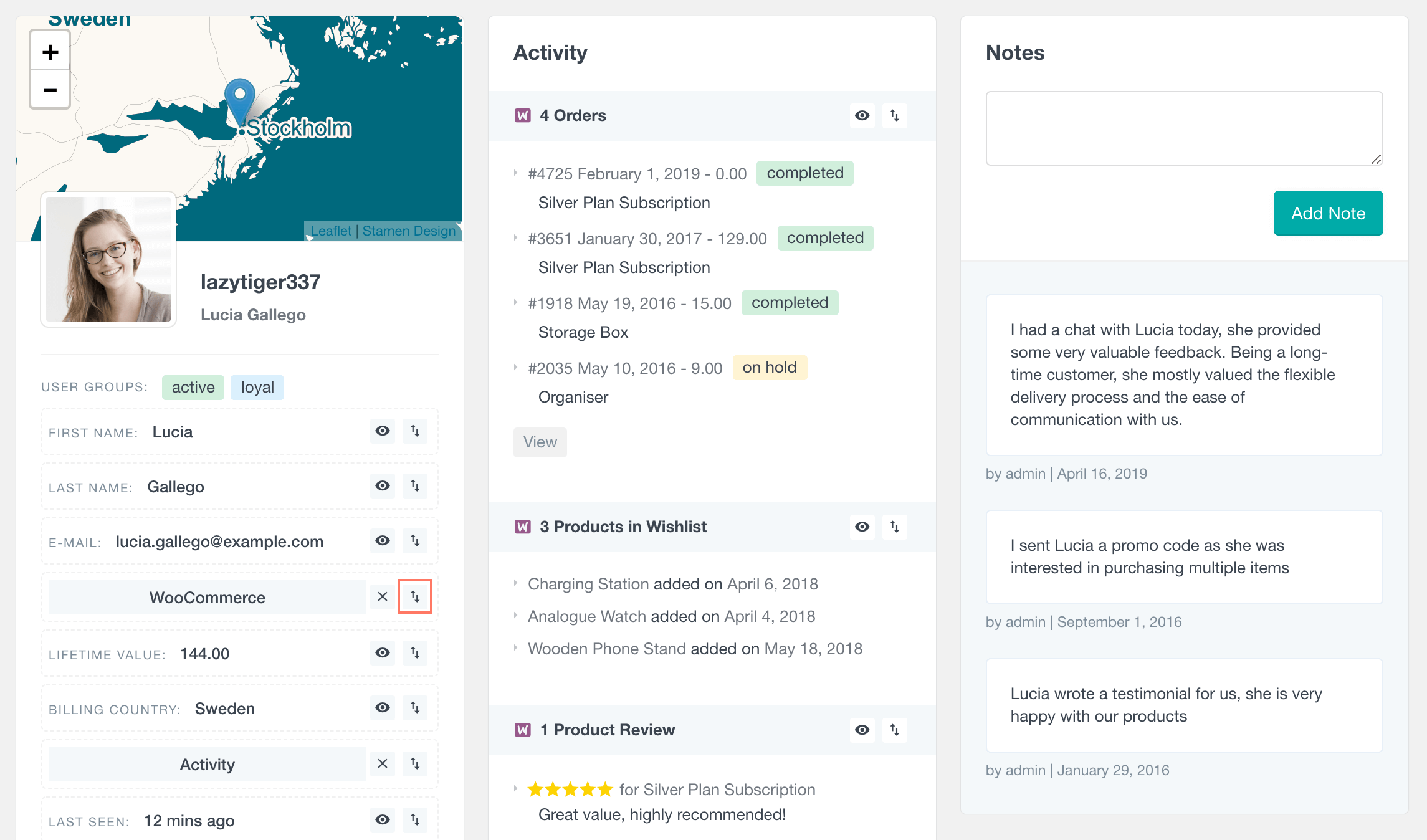
Reordering and hiding fields
Another great addition is moving around your custom user fields as well. In the same way, you can move your groups; you can move fields to find an order that works best for you.
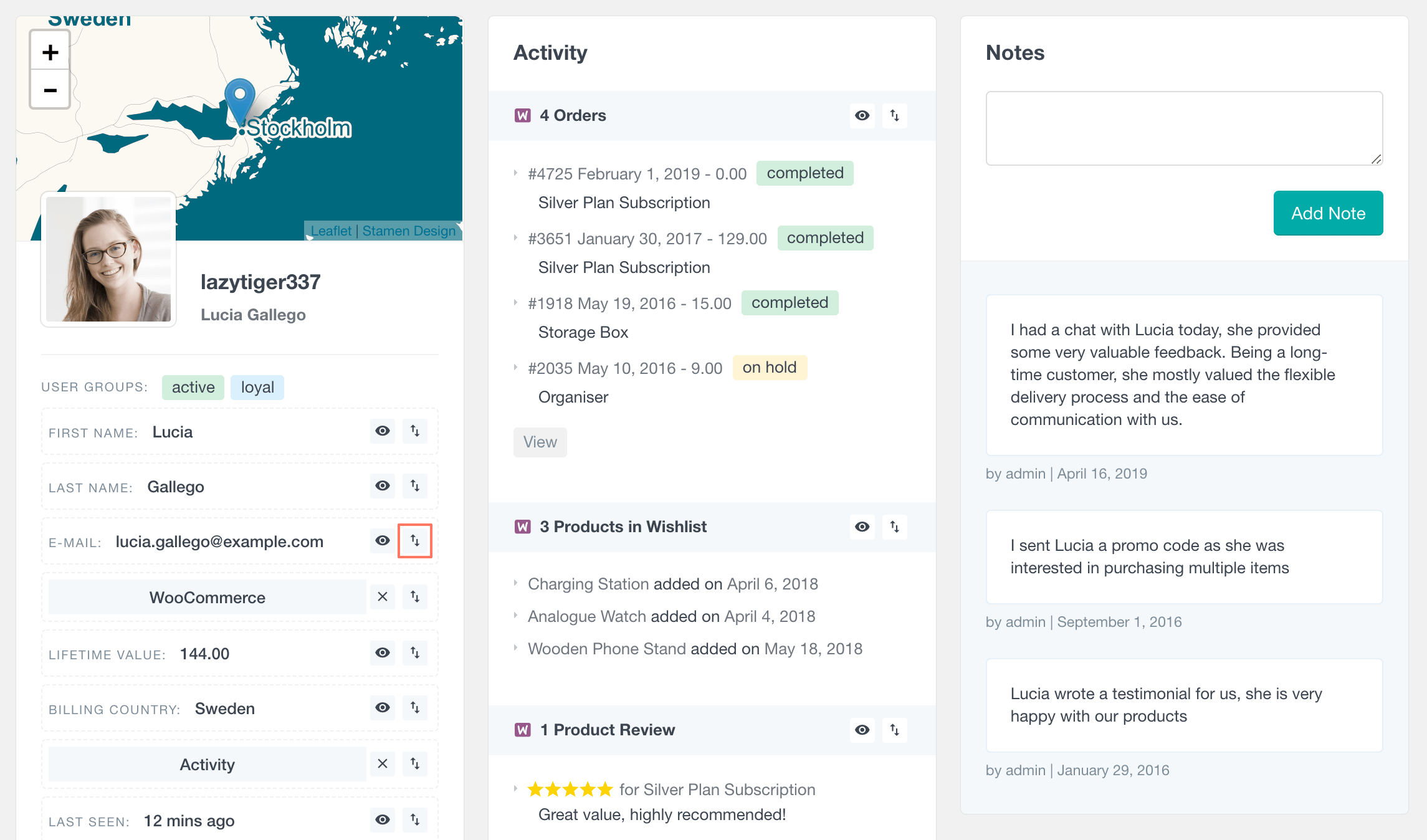
Although many custom fields are helpful, sometimes we want the main information. With profile settings, you can hide some of the custom fields. Thus, you can achieve your desired organization.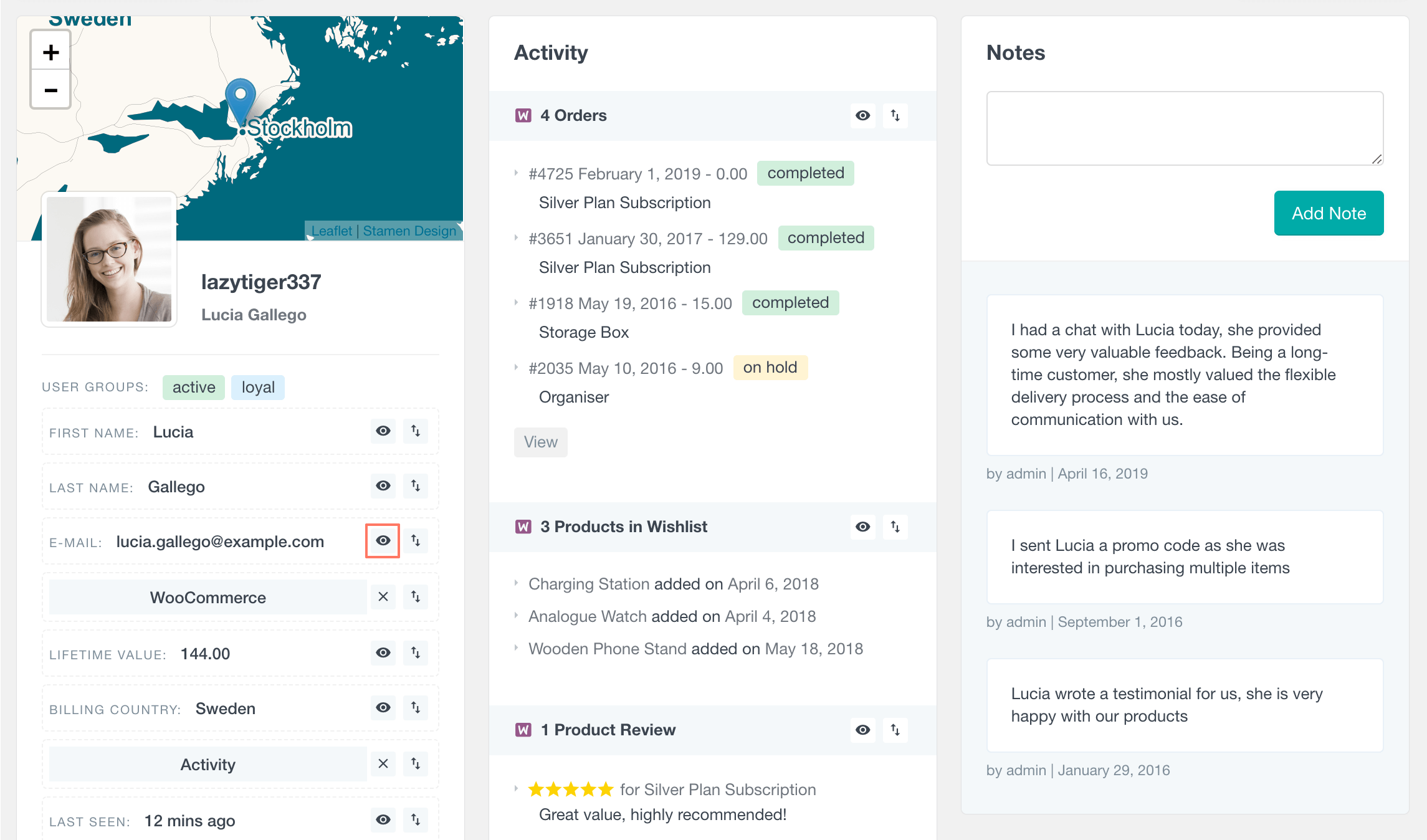
You can reorder or hide sections from the Activity section, like the custom fields, from the Profile Settings screen. All settings regarding profile customizations (show/hide fields and order) are user-based, meaning that every administrator can apply their own custom “view” depending on the data they most commonly use.
Conclusion
A WooCommerce customer profile builder is a plugin that allows you to create custom customer profiles for your WooCommerce shop. You can use this feature to store custom customer information that can be always available for you and your team. You have successfully created your custom profile page with the Users Insights WooCommerce customer profile builder plugin.
With our custom WooCommerce profiles, you can capture and manage far more data about your customers, but all this information can also be easily searchable and accessible via the Users Insights filters. We hope this article helped you improve your customer management and organization.
